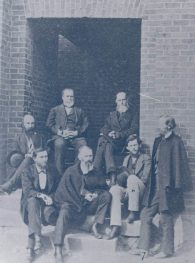NEWS
Life in Davidson in the Early 1870s

On May 26, 1939, the Chapel Hill Weekly published Lucy Phillips Russell’s memories of life in Davidson in the 1870s. This account is enhanced by the contents of a letter Lucy wrote in 1920, and some observations by her aunt, Cornelia Phillips Spencer, written after a visit in 1870. Lucy Russell’s father Charles Phillips was a professor of mathematics at the University of North Carolina when the hardships of Reconstruction “turned the members of the…faculty out.” He was then hired to teach at Davidson, and the family of eight traveled to Charlotte in February of 1869, arriving by carriage to Davidson after “a 20 mile drive over a partly frozen red-mud road.” Their household goods followed them “in wagons over the inexpressible roads.”
Lucy Russell’s account is startling to those who live in the bustling town today.. The first house they passed in the tiny village was that of college professor John Rennie Blake and his wife (then situated where CVS is now). They were greeted at the gate by Elizabeth Blake, who was small with “chestnut hair…brushed with…satin smoothness” and blue eyes and quick movements like Lucy’s mother, Laura Phillips. This was the beginning of a 60-year friendship between the two women. The Phillips family spent the night at the home of college president George McPhail, whose “stately wife, in a cap of fine lace with wide flowing strings” received them “with Virginian hospitality.”
The McPhails’ two daughters, however, declared the Phillips children to be “the noisiest children they had ever seen.” In her letter, however, Lucy declared that “Nothing would exceed the cordiality of our reception.” They eventually settled in a house on North Main Street called The Oak, named for the huge oak tree that formed the only cover over the porch. Russell described it as “A very simple home,” but added that “all homes were simple in those after-the-war days.” Lucy, who was eight at the time, slept in a closet adjacent to her mother’s room, with no heat but her mother’s fire.

Davidson College Faculty c 1873 Front, from left: Professors Latimer, Martin, Winn, and Blake. Seated, left to right: Richardson, Phillips (Lucy’s father) and Anderson. (photo courtesy of Davidson College Archives)
There were fewer than 20 houses along Main Street when the Phillips’s arrived. There were only two stores, one owned by Mr. Helper and one by “Fran-pap” Allison. In her 1920 letter, Lucy described Davidson as “A simple, pious community…full of loving-kindness and hospitality. Every body was poor, because the whole South was, no body had a carriage, no fine clothes, no fine houses. Every body lived in charity with every body else, nursed each other in sickness, wept with each other in times of sorrow and death, enjoyed with each other when fortune smiled.” Life in the small town centered around the church and the college. The college faculty consisted of only six members; three of these were ministers. The small student body, according to Russell, “resulted in very close contact between teachers and pupils.”
Lucy Phillips had vivid memories of the professors. “One of the professors [William G. Richardson] was an accomplished flutist and was therefore considered rather frivolous. He was the man who wrote to the authoress, Miss Marian Evans, to ask her the meaning of some of the words in her novel, ‘Saint Elmo.’ [Note: Augusta Jane Evans, a Southern writer, actually wrote Saint Elmo.] She replied that really it was impossible for her to furnish food for thought and the brains to understand. He laughed heartily at the joke on himself, framed her autographed letter, and hung it on his parlor wall.”
The students had decided on nicknames for every professor. “Rev. J. M. Anderson was ‘St. John,’ from the saintly sweetness of his face and character. Professor J.R. Blake was ‘Felis,’ from the silent, catlike way he could slip up on a student out of his room during the period for study. My father was ‘Fatty,’ for obvious reasons. Professor Richardson was ‘Old Dick.’”
According to Russell, “There seems to be an impression in these undisciplined days that a childhood spent in a Calvinistic, puritanical home was joyless, austere, grim, repressed. The very air of Davidson was saturated with the doctrines of the stern Frenchmen, yet the children were gay, jolly, and mischievous, and most of them were not repressed half enough. If they were victims of any sort of tyranny, they did not know it and were just as happy as children anywhere. The older men had their teaching and preaching and studying to look after; the older women were engrossed in housekeeping, caring for the sick and the strangers who so often came within their gates. It was the young ladies who suffered most from whatever repression there was.”
According to Russell’s 1920 letter, there were few young ladies in town: Mary and Lily McPhail, Mary and Sue Anderson, and Lucy’s own 17-year-old sister, Mary. The girls formed a Secret Society “with the mysterious title of ‘I.S.H.H.’ and scoffers translated it as ‘I shall have a husband,’ but it really meant. ‘Independent seekers of Health and Happiness’ and they took long walks together every afternoon.”
In her 1939 article Lucy noted that “Dancing was not so much as spoken of, cards were still more taboo, parties were condemned. There was one croquet set in the village, but tennis, golf, riding, swimming had not been so much as thought about. There were plenty of dates, and formal calls; long walks in the shadowy woods that grew close up to the village gave ample opportunity for love-making [which in this case probably refers to courting].”
As for church life, “Every Saturday afternoon the children met to recite the Shorter Catechism, to a member of the faculty.” Lucy added, tongue-in-cheek, that “on occasions of delirious festivity we had ‘The larger Catechism, with proofs. Sometimes those scenes of joy and gladness were varied by a ‘Singing’, also in the chapel, led by the students.”
Saturday afternoon choir practice for the older youth was, however, quite a social occasion. The choir was composed of students or young tutors who were “elected to the chapel choir by reason of a sonorous bass or a soaring tenor voice.” Each week, one of these young men would write to a girl and ask to accompany her to choir practice. Meanwhile the girl “had been on tenter-hooks lest the wrong man ask this privilege, or no man at all.” The young man prepared by bathing in a round tin tub, “filled with water drawn from the college well and heated in a kettle upon his open fire.”
He then donned his church clothes. As for the girls, “After a few moments of coy delay the young lady joined her escort, and they walked demurely across the street and ascended the steps of ‘the old Chapel’ (later Shearer Hall)…The organ was very small, and so was the organist, Miss Mary McPhail.” Voices, having been carefully chosen, were good “and the stately hymns of our church never sounded more sweet.” After practice “there was a decorous walk home or one equally decorous in the friendly woods nearby.”
Lucy’s aunt Cornelia Phillips Spencer, after an 1870 visit to Davidson, also described life in the small village. According to the Davidson Monthly, she called Davidson “the quietest place in the State…As to dissipation I don’t suppose there is so much as a cigar going there. A deep snow and a rabbit-hunt are all the young gentlemen have to look forward to, and to ensure the latter, the former must always happen on a Saturday.” According to Mrs. Spencer, the students led monotonous lives, “broken only by such diversions as being invited to the Sampsons’ to eat supper and play Authors, and to stand around their little organ on Sunday evenings and sing after supper until time for church.”
According to Lucy, however, the town came alive at Commencement. With no hotel in town, attendees were housed in private homes, and “every house was full to the bursting point, and as there was no R.R. and no regular schedule for arriving and departing, guests were apt to appear at any hour of day or night and children were accustomed to be routed out and stowed away…to give place to guests.” The grand event of commencement was the Promenade concert, for which “the society halls were brilliantly illuminated and decorated and the prettiest girl who had received the Chief Marshall’s regalia queened it in the President’s chair. There was no dancing of course.”
When the University reopened in the mid-1870s, Professor Phillips, who had put the college’s math curriculum on a sound footing, returned to Chapel Hill to teach. Lucy declared that she was “glad I spent part of my childhood there and cried all the way to Charlotte when I left.” The family maintained some ties to Davidson. Two of the Phillips boys graduated from Davidson College, James (1874) and William Battle (1877). Their oldest daughter, Mary, married Davidson College alumnus John D. Verner. And there remained fond memories, as well as the life-long friendship between Elizabeth Blake and Laura Phillips.
Sources:
Lucy Russell’s 1920 letter is available in the Davidson College Archives, and is also available digitally on the Archives webpage. Cornelia Phillips Spencer’s reminiscences are also available in the Davidson Monthly in the Archives.
Nancy Griffith
Nancy Griffith lived in Davidson from 1979 until 1989. She is the author of numerous books and articles on Arkansas and South Carolina history. She is the author of "Ada Jenkins: The Heart of the Matter," a history of the Ada Jenkins school and center.


